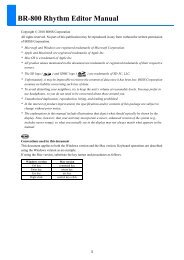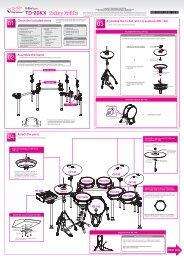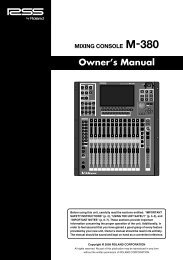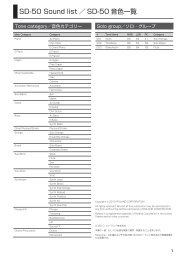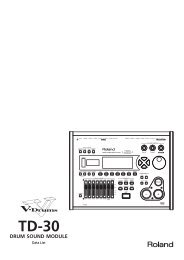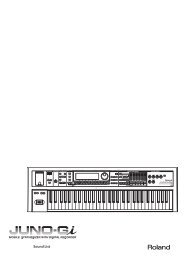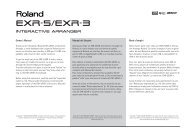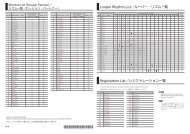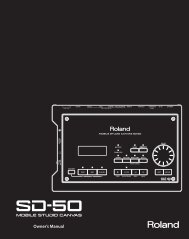GAIA Exploring Sound (PDF) - Roland Corporation Australia
GAIA Exploring Sound (PDF) - Roland Corporation Australia
GAIA Exploring Sound (PDF) - Roland Corporation Australia
You also want an ePaper? Increase the reach of your titles
YUMPU automatically turns print PDFs into web optimized ePapers that Google loves.
What’s Wrong With This <strong>Sound</strong>?<br />
To put it a little better; what’s wrong with this trumpet? Here are a<br />
few steps to explain the thinking involved and some methods to<br />
improve the sound.<br />
1. From the early part of this lesson you would probably guess<br />
that the problem has something to do with the Envelope. In<br />
particular, the Attack of the sound is all wrong. It sounds like<br />
we are hitting the trumpet, but it should sound like we are<br />
blowing into the mouthpiece.<br />
2. So experiment with the Attack slider. Of course, it is very easy<br />
to raise the slider too much, making the sound even less like a<br />
trumpet. For now, try an Attack level of around 3. Does it<br />
sound like a “puff?” Like blowing into the mouthpiece?<br />
3. Now what’s wrong with this trumpet? Logically, the trumpet is<br />
an acoustic instrument. You blow in the mouth piece and the<br />
air travels through the body of the trumpet and out to our ears.<br />
So it would seem very unlikely that the sound could possibly<br />
stop instantly. Experiment with the Release control until it<br />
sounds natural to your ears. Perhaps you could set the<br />
Release to about 8.<br />
4. What’s wrong with the trumpet now? This is where the<br />
remaining two controls can be very useful. If you have ever<br />
tried to play a brass instrument you will know that the hardest<br />
part is getting the sound started. After that it is relatively easy<br />
to maintain the note. So how do we recreate this extra effort at<br />
the beginning of the note? How do we re-create a puffing<br />
effect?<br />
5. Look again at our Figure 5.6 Envelope Shape<br />
envelope shape in Figure<br />
5.6. Notice that the<br />
greatest level happens at<br />
the beginning, but then<br />
fades to a lower level.<br />
Does this suggest extra<br />
effort at the beginning of<br />
the note? How did we get<br />
that shape?<br />
6. So try setting the Sustain to 90, and the Decay to around 20.<br />
Now the sound is much more like a trumpet. Indeed, if you<br />
were to buy an electronic organ back in the early 1960s which<br />
offered a trumpet sound, this is exactly what you would have<br />
heard.<br />
7. Take particular note of the Sustain level. If we had left it set at<br />
it’s maximum then the Decay would have had no effect at all.<br />
The Decay and Sustain controls often work hand in hand like<br />
this.<br />
57




